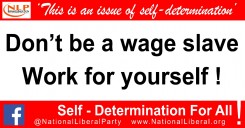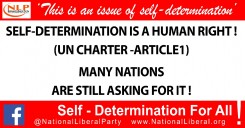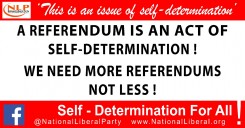ELECTORAL COALITIONS – PART II
In our first article we postulated the theory that small Centrist groups and parties (although ultimately all those outside the ‘Establishment’) can best achieve local electoral success by organising pacts with other groups or independents. The benefits would be a pooling of funds, greater credibility and the ‘Fourth Vote’.
Furthermore, whatever electoral system does or does not develop in the UK we do not believe one ‘outside’ group will or can ‘take power’ at the national level. Even if such a group could broaden its appeal across class and social divides the existing three traditions will not simply melt away but will, at best, remain as ‘rumps’. They will if necessary co-operate against the outsiders and form coalitions themselves when deemed necessary.
In recent times the most successful new parties have been single-issue based (whether openly or in practice). Whilst appealing to some they seem unable to meaningfully add on other policies because their appeal, and therefore their recruitment, is largely confined to those ‘obsessed’ with their single-issue. They are not interested in losing that focus.
Also in order to take root within local communities these groups will also tend to take on the characteristics of ‘their’ community (whether social or class), recruit accordingly and potentially put off others not from that milieu. Ultimately ‘outsider’ groups may have to consider co-operating in order to achieve some local goals as well as a national presence. Of course all the problems faced with brokering local electoral alliances will be magnified nationally but that of course is the challenge modern successful outsiders need to face.
The challenges for any alliance to meet/overcome are:
Policy
Perhaps this is the most difficult subject with which to find consensus. It would have to be a very basic platform and relevant to the body you are trying to become elected too i.e. if council then national politics will not be as relevant. Look at the body in question and decide what its ‘Achilles Heel’ is i.e. large Council Tax increases or some recent scandal. Create a Steering Committee from amongst potential partners to flesh this out. The minimum is two, maximum at this stage probably three – they could come from parties but might also be independents, whether as individuals or non-party registered pressure groups. We are not talking about ‘bogus’ coalitions of real or fictitious ‘front’ groups that just happen to come together!
The constituent parts would still be free to promote other policies/campaigns and providing these are not contradictory, embarrassing or offensive (see extremists below) should not reflect badly on the others. Certain policies that could not obtain all round agreement due to differences or the need for brevity for the Coalition Campaigning body may help a particular constituent group elect their candidates. In most cases we believe the ‘edge’ of the smaller parts will be reflected in personality/charisma and community politics/links.
Remember that the greater the platform the greater the potential for disagreement and less the impact upon the electorate. Finding the right balance is crucial.
Extremists
Perhaps the most contentious subject. Clearly one wouldn’t want the Coalition to be hijacked by the most fanatical i.e. ‘extremist’ group or allow itself to be overshadowed by its most controversial member. Not every party will be suitable and all partners must have a sincere desire to co-operate. It should not (be allowed) to be used as a means to get elected and then for members to ‘do their own thing’. The Steering Committee’s decision is vital and must be final. There is an element of trust here so choosing the ‘right’ partners is essential. The varying strengths of partners will manifest itself within individual constituencies rather than within or through the coalition, all partners at this level are equal.
Personalities
Perhaps the most frustrating element. Anyone involved in so-called ‘Unity’ talks will know that this is often the most problematic factor that prevents agreement. This is because individuals want to control things and see position(s) as the key. Individuals, particularly independents, will not be a problem as they will see the coalition as their best chance of becoming elected and seek power largely to improve their own area (which is usually their raison d’être). The pre-elected Coalition however has no power to exercise or give. It is purely a vehicle to promote its constituent parts. It is an electoral PR machine. The only ones that can exercise ‘power’ are those candidates that are actually elected.
The coalition will (hopefully) be mirrored in the chamber but it may not include of course all the original constituent partners i.e. not every group or individual will become elected. The electoral coalition (as apart from the one represented in the chamber) can remain in hibernation for future elections and/or as a Press Office for a working coalition (in or out of power).
Promotion
Once the Partners have been found (and this is a major promotional challenge in itself but is achievable) and a basic platform created, then the Coalition needs to be promoted (the optimum lead time of its launch before an election is still a ‘work in progress’). This should include a Press Launch and Promotional Material (adverts and mail-outs). Who produces the material, who pays for it and distributes it (particularly in areas untouched by partners) is down to the Steering Committee. Rather than open up a bank account, an invoice can be split x ways (there are some minor regulatory implications for Parties).
The fundamental aim, at first, is to advertise for more partners and specifically candidates. Later it will be to advertise its existence, largely around policy. That should of course link the basic platform to electoral issues (that will be fought at a forthcoming election).
In the election the individual partners will promote their own candidates with their own (and if a target ward, their best) material. We have experimented at a local level with public Coalition material. It doesn’t work for it tends to confuse voters. Far better to simply have a standard logo and slogan on everyone’s bespoke material. It is in everyone’s interests for the Coalition to prosper so the wealthier partners may need to carry some of the others, in particular individuals standing as Independents. In this way everyone’s a winner!
There are many small political parties out there crying out to be heard. There is no need from to give up or to merge. If they simply co-operate with others in the same situation they can retain their ‘independence’ yet benefit from working with others. Are you an Independent or an official of a small ‘centrist’ party? Want to be a part of something new and progressive? Then contact the NLP at natliberal@aol.org for more info on the ‘People’s Alliance (UK)’.
Date: February 10, 2010
Categories: Articles































